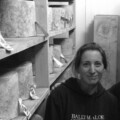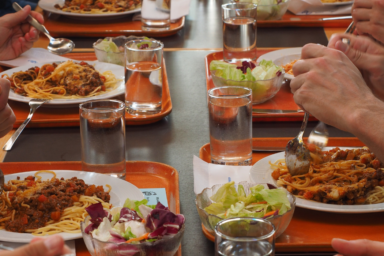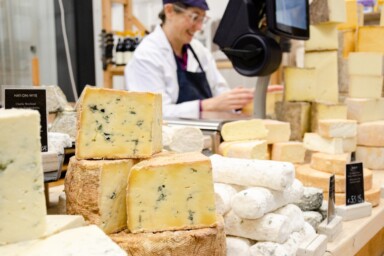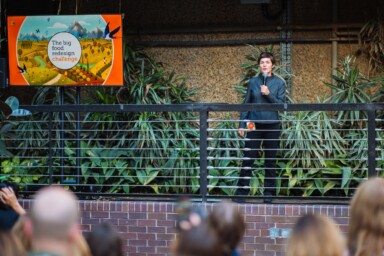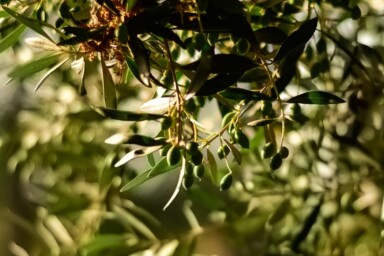Patrick, Sustainable Food Trust CEO, and Becky Holden run Bwlchwernen Fawr, a 300-acre farm, 10 miles from the Ceredigion coast in West Wales. They produce Hafod, a raw milk cheese, from the milk of their Ayrshire dairy herd. They have become involved in Llafur Ni, a project of the Gaia Foundation, working with other Welsh farmers to cultivate and restore the black and grey oats that were a staple feed and food source of farmers. Becky Holden writes about the importance of these grains.
Grains have always been a staple of the Welsh diet and cereal growing was part of the tapestry of the Welsh landscape until just a couple of generations ago. In Carwyn Graves’ beautiful book, Welsh Food Stories, his chapter on bread mentions that in our county of Ceredigion alone, there were 150 corn mills in the 1850s. The varied geology and climate in Wales ensured a diverse map of grain growing and it was the hardy, adaptable oat that was most suited to wet, westward hills like the one our farm sits on. But by the 1950s, cereal growing in this part of Wales was disappearing, along with mixed farming – replaced by increased scale and ‘specialisation’ and our ‘less favourable’ land areas being seen as only good for growing grass.
February brings a sense of anticipation, with warming soils and emergent growth. As well as thinking about pasture and grazing, we are planning which fields in our arable rotation will grow oats in 2023 – at the moment, it’s looking like Gelli Fach Maximus, Golden Chain and Cae Banc. We are still a mixed livestock farm and Patrick has been growing three or four fields of spring sown cereals in rotation over about half of the farm for 50 years now, (the rest is permanent pasture). It’s mostly oats or barley as feed for our cows, but in his early years of farming he grew wheat for milling that he sold to an Aberystwyth whole food shop.
Growing cereals has always been an important part of our farm’s ecosystem and enhances our farm biodiversity, as well as contributing to our self-sufficiency in feed and bedding. Touch wood, we always manage to get the grain and straw in, despite the small window of opportunity to harvest in September; overcoming the weather challenges we face certainly increases our satisfaction at seeing the oat seed sown in the spring, transformed into a bin full of grain and a barn full of straw.
We have, however, always been frustrated that we were not adhering to our principles of the circular economy and minimal external inputs by buying a couple of tonnes of anonymous organic seed in the spring rather than looking for and stewarding locally adapted varieties or even saving our own surplus and developing a Bwlchwernen landrace.
A few years ago, we heard about the Gaia Foundation’s Seed Sovereignty project in Wales, Llafur Ni (‘Our Grains’). The story of its origins is rightly rooted in Welsh culture, song, history and people and captured in this wonderful film. We joined the group because we wanted to support the network of farmers, growers and millers, as well as historians, researchers and enthusiasts that were growing and ‘bulking’ (growing seed to increase seed stocks) rare Welsh heritage grain seed varieties. A few traditional watermills are now restored and working again, like Felin Ganol, and are at the heart of the Welsh grain revival.
Tiny envelopes of seed were entrusted to the group by Aberystwyth University. These seeds had been locked away for preservation, with an assumption that they would never be grown again, as modern ‘improved’ varieties replaced them. Other samples were still being actively cultivated at field scale, like the two sweet jars of Ceirch Du (black oats) and Ceirch Llwyd (grey oats) seed that we received, which originated from the farm of the legendary Iwan Evans Coedfadre, who was possibly the last farmer quietly growing them year after year to feed his chickens.
We marked out a small plot at the boundary of west facing First Hay field and scattered just over two-and-a-half kilos of the precious seed by hand and then raked it in. Although our fields are small compared to an arable farmer’s, our grain growing is still mechanised and mostly carried out by contractors. It was enlightening to return to growing grain on a human scale, tuning in more physically and emotionally to the soil and the seeds, but also to the reality of how challenging and anxiety inducing that small crop was. We scrutinised the soil for emergence and carefully hand weeded around our tiny plants. As the season went on, we marvelled at the deep green colour and resistance to lodging (the bending of the stems) of these tall traditional oats compared to their mechanically drilled modern neighbours in the same field. In the weeks before harvest, we agonised in wonder as the usual arrival of crows, pigeons and badgers – capable of decimating our grain crops – appeared to home in on the Ceirch Du and Ceirch Llwyd. Did they instinctively recognise a superior nutrient density?
The seed that we sowed was by no means pure. It was a mix of the rare black and grey oats along with white and wild oats and so the challenge at harvest (again by hand) was to try to eliminate in the field some of the white and wild grains. I took our first harvest of a few sheaves to Iwan’s farm where the Llafur Ni group threshed the many varieties, grateful that Iwan had preserved not only the grey and black oats but also the threshing machinery and the wisdom, knowledge and experience of previous generations. From the sowing to the harvesting, threshing and sorting, these tiny seeds had brought people together in toil, around the table, in song and in laughter.
That 2021 bulking meant that we had enough seed to move to the machine drill and combine in 2022. We still felt the same deep connection to this rare oat but could now start to experience its adaptability and viability at farm scale. Our earliest ever harvest on 15th August, saw the combine pass through the Ceirch Du and Ceirch Llwyd at dusk and empty the bounty into a half-tonne dumpy bag. The sample was dry and clean and is stored suspended from a barn roof (out of reach of the rats, mice and squirrels that seem to prefer it to modern grain too!). We estimate that there is enough to sow two acres in 2023.
The seed remains the property of the Llafur Ni network. Their vision, however, is not just to preserve these rare grain varieties but to revive them and to see them grown and processed widely to feed people and livestock, just as they were traditionally. We haven’t attempted to mill the oats yet or even tasted them beyond nibbling the grain, but the black oats in particular have a shine that must reflect a good oil content. Llafur Ni is investigating processing and testing the nutritional value and taste of the various grains to ensure their revival is viable. Given how successfully Ceirch Du and Ceirch Llwyd have grown in our fields, we can really start to imagine a resilient landscape of heritage oats replacing the bought-in grain seed on the farm in just a few harvests.
Llafur Ni – Our Grains tells the story of how Gerald and Iwan came to meet through singer Owen Shiers, the blossoming Llafur Ni Network and The Gaia Foundation’s UK & Ireland Seed Sovereignty Programme.
Image copyright Rebecca Holden.

